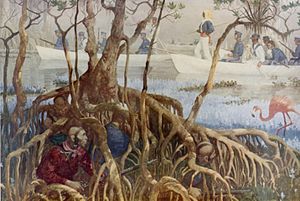
Back حروب السيمينول Arabic Guerres Seminolas AST Seminol müharibəsi Azerbaijani سمینول ساواشی AZB Guerres Seminola Catalan شەڕەکانی سیمینۆل CKB Seminolekrigene Danish Seminolenkriege German Guerras semínolas Spanish Gerra seminolak Basque
| Seminole Wars | |||||||
|---|---|---|---|---|---|---|---|
| Part of the American Indian Wars | |||||||
 A U.S. Marine boat expedition searching the Everglades for Seminoles during the Second Seminole War | |||||||
| |||||||
| Belligerents | |||||||
|
|
Seminole Yuchi Choctaw Black Seminoles | ||||||
| Commanders and leaders | |||||||
|
William McIntosh (Coweta Creek) |
Abiaka Micanopy Tiger Tail Chipco Osceola John Horse Holata Micco Josiah Francis Homathlemico † Garçon Neamathla Oponay Coacoochee (Wild Cat) Tukose Emathla (John Hicks) Yuchi Billy Halleck Tustenuggee Halleck Hadjo Hallapatter Tustenuggee (Alligator) Chakaika Abraham Bolek King Phillip Ote Emathla (Jumper) King Payne Oscen Tustenuggee Cappachimico Thomas Perryman Kinache Peter McQueen | ||||||
| Strength | |||||||
| Peak: 40,000 Expeditionary: 8,000[1] | 1,500[1] | ||||||
| Casualties and losses | |||||||
| Militia and civilian deaths unknown | Heavy | ||||||
The Seminole Wars (also known as the Florida Wars) were a series of three military conflicts between the United States and the Seminoles that took place in Florida between about 1816 and 1858. The Seminoles are a Native American nation which coalesced in northern Florida during the early 1700s, when the territory was still a Spanish colonial possession. Tensions grew between the Seminoles and American settlers in the newly independent United States in the early 1800s, mainly because enslaved people regularly fled from Georgia into Spanish Florida, prompting slaveowners to conduct slave raids across the border. A series of cross-border skirmishes escalated into the First Seminole War, when American General Andrew Jackson led an incursion into the territory over Spanish objections. Jackson's forces destroyed several Seminole, Mikasuki and Black Seminole towns, as well as captured Fort San Marcos and briefly occupied Pensacola before withdrawing in 1818. The U.S. and Spain soon negotiated the transfer of the territory with the Adams-Onis Treaty of 1819.
The United States gained possession of Florida in 1821 and coerced the Seminoles into leaving their lands in the Florida panhandle for a large Indian reservation in the center of the peninsula per the Treaty of Moultrie Creek. In 1832 by the Treaty of Payne's Landing, however, the federal government under United States President Andrew Jackson demanded that they leave Florida altogether and relocate to Indian Territory (modern day Oklahoma) as per the Indian Removal Act of 1830. A few bands reluctantly complied but most resisted violently, leading to the Second Seminole War (1835-1842), which was by far the longest and most wide-ranging of the three conflicts. Initially, less than 2000 Seminole warriors employed hit-and-run guerilla warfare tactics and knowledge of the land to evade and frustrate a combined U.S. Army and Marine force that grew to over 30,000. Instead of continuing to pursue these small bands, American commanders eventually changed their strategy and focused on seeking out and destroying hidden Seminole villages and crops, putting increasing pressure on resisters to surrender or starve with their families.
Most of the Seminole population had been relocated to Indian Territory or killed by the mid-1840s, though several hundred settled in central and southern Florida, where they were allowed to remain in an uneasy truce. Tensions over new settlement in the state under the Armed Occupation Act of 1842 south of Tampa led to renewed hostilities, and the Third Seminole War broke out in 1855. By the cessation of active fighting in 1858, the few remaining bands of Seminoles in Florida had fled deep into the Everglades to land unwanted by American settlers.
Taken together, the Seminole Wars were the longest, most expensive, and most deadly of all American Indian Wars.
- ^ a b c Kohn, George Childs (2004). Dictionary of Wars: Third Edition. United States of America: Checkmark Books. p. 486. ISBN 0-8160-6578-0. Retrieved 17 July 2017.
- ^ "Timeline of the Florida Seminoles". Florida Memory. State Library and Archives of Florida. Archived from the original on 14 February 2018. Retrieved 27 April 2018.
- ^ Kohn, George Childs (2004). Dictionary of Wars: Third Edition. United States of America: Checkmark Books. p. 486. ISBN 0-8160-6578-0. Retrieved 18 July 2017.
- ^ Bluhm, Raymond K. "Seminole Wars". Encyclopædia Britannica. Archived from the original on 11 April 2019. Retrieved 18 July 2017.
As many as 2,000 U.S. soldiers were killed in this prolonged fighting, which cost the government between $40,000,000 and $60,000,000. Only after Osceola's capture while parleying under a flag of truce did Indian resistance decline. With peace, most Seminoles agreed to emigrate. The Third Seminole War (1855–58) resulted from renewed efforts to track down the Seminole remnant remaining in Florida. It caused little bloodshed and ended with the United States paying the most resistant band of refugees to go West.